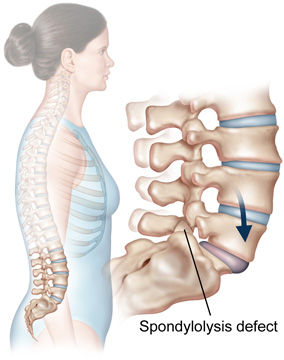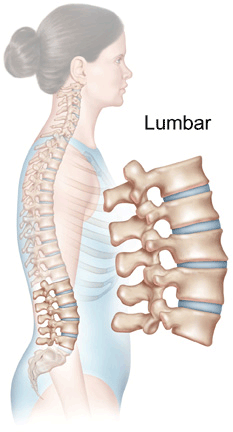Spondylolysis and Spondylolisthesis

Introduction
The bones of the spine are arranged to give the spinal column stability. Damage or defects within the supporting structures of the lumbar spine can be a source of back pain. A crack in the bony ring of the spinal column is called spondylolysis. If the crack occurs on both sides of the bony ring, the spine is free to slip forward, a condition called spondylolisthesis. About five to six percent of the population is affected by these two conditions.
Learn about spondylolysis and spondylolisthesis including
- what causes the conditions
- how a diagnosis is made
- what treatment options are available
Anatomy
In order to understand your symptoms and treatment choices, it is helpful to start with a basic understanding of the anatomy of your low back. This includes becoming familiar with the various parts that make up the lumbar spine and how these parts work together.
Causes
Spondylolysis describes a defect in the bony ring of a vertebra. It mainly affects the lowest lumbar vertebra. The bony ring, formed by the pedicle and lamina bones, protects the spinal cord and spinal nerves. The bone is weakest between the pedicle and lamina, an area called the pars interarticularis-"pars" for short. A pars defect is believed to be a stress fracture. A stress fracture happens from repeated strain on a bone. At first the body is able to heal the damage. If the repeated strains happen faster than the body can respond, the bone eventually fractures. People are not born with spondylolysis. It commonly first appears in childhood. Football linemen and gymnasts are affected the most.
Spondylolisthesis describes a vertebra that has slipped forward on the vertebra below. This usually occurs when a vertebra has a bony defect (spondylosis) on both sides of the bony ring. A crack on both sides of the bony ring separates the facet joints from the back of the spinal column. The facet joints can no longer steady the vertebra. The vertebra on top starts to slide forward, slowly stretching the disc below the damaged vertebra. In adults, there is usually no danger that the vertebra will slide off the vertebra below. But teenagers sometimes have a unique type of spondylolisthesis in which one vertebra slips forward and slides completely off the vertebra below.

Symptoms
Spondylolysis and spondylolisthesis can be a source of low back pain. Yet having one of these conditions does not mean you are certain to have back problems. It does put you at higher risk compared to people who don't have them. These conditions can cause mechanical pain-the kind that comes from within the moving parts of the spine. They can also cause compressive pain, which is from pressure on the nerves of the low back.
Pinched or irritated nerves produce compressive symptoms. This occurs in spondylolysis when a lump of tissue forms around the crack-where the body tries to heal the stress fracture. The lump can cause pressure on the spinal nerves where they leave the spinal canal. A pinched nerve can also happen in spondylolisthesis when the vertebra slides forward and squeezes the nerve. The forward slip of the vertebra also makes the spinal canal smaller, leaving less room for the nerve roots.
Pressure on the nerve can produce pain that radiates down to the foot. It can also cause numbness in the foot and weakness in the muscles supplied by the nerve.
Diagnosis
History
In order to make a proper diagnosis and rule out other possible conditions, the first step is to take a history. This includes finding out about
- Date of Onset - When did you first notice the appearance of your spinal condition?
- The Presence or Absence of Pain - Not all cases of spondylolysis produce pain. If there is pain, the doctor will need to know where it is, what brings it on or intensifies it, and if there is any radicular pain. Radicular refers to pain that radiates away from the spine to other parts of the body.
- Bowel or Bladder Dysfunction - Are you having problems knowing when you have to urinate or have a bowel movement? This is extremely important because it could signal the presence of serious nerve damage.
- Motor Function - Has there been a change in how your muscles work? This may be the result of pressure on the nerves or spinal cord itself.
- Previous Surgery - If you have had any surgery on your spine, it may have caused some type of degenerative spondylolisthesis. In order to evaluate your condition properly, it is important that your doctor knows about any spinal surgery you have had in the past.
Physical Exam
Your doctor will then perform a physical exam and try to get an understanding of your back problem and how it is affecting you. Your nerves will also be tested by checking your sensation, your reflexes, and the strength of your muscles. Learn more about physical exams for back problems.
Diagnostic Tests
X-rays are often all that are needed to see a pars defect or forward slip of a vertebra. A defect on X-ray does not confirm your back symptoms are coming from the defect. X-rays will help your doctor measure any slippage from possible spondylolisthesis.
Other conditions, such as a herniated disc, may be the actual cause of your symptoms. Your doctor will carefully look for all possible causes of your symptoms, which may involve other tests. The most common tests that are ordered are: an MRI - to look at the nerves and spinal cord; a CT scan - to get a better picture of the vertebral bones; and special nerve tests - to determine if any nerves are being irritated or pinched.
Treatment Options
Conservative Treatment
Treatment for spondylolysis and spondylolisthesis is similar to treatments for other causes of mechanical and compressive back pain. Surgery is rarely necessary. Doctors may prescribe rest, including avoidance of sport activities, to help calm symptoms from mechanical back pain. Special braces, casts, or corsets are used to help heal a stress fracture and to ease pain.
Physical Therapy
Your doctor may have you work with a physical therapist. A well-rounded rehabilitation program assists in calming pain and inflammation, improving your mobility and strength, and helping you do your daily activities with greater ease and ability.
Positions, movements, and exercises are prescribed to reduce pain. Hamstring flexibility is addressed, along with strength and coordination exercises for the low back and abdominal muscles. Sports participants benefit with an assessment of their technique and equipment. Therapy sessions may be scheduled two to three times each week for up to six weeks.
The goals of physical therapy are to help you
- learn to manage your condition and control symptoms
- learn correct posture and body movements to reduce back strain
- maximize your flexibility and core strength
Learn more about spinal rehabilitation.
Medication
Medications may be used for short periods to control pain, ease muscle spasms, and help regain a normal sleep pattern (if you are having trouble sleeping). Short periods of bed rest may help with acute painful episodes.
Learn more about medications used to treat back pain.
Surgical Treatment
Surgery is necessary only if conservative treatments fail to keep your pain at a tolerable level. Surgical treatment for spondylolysis and spondylolisthesis must address the presence of mechanical and compressive symptoms.
Nerve pressure may require surgical decompression, called decompressive laminectomy of the lumbar spine. In order to free up or "decompress" the nerves, the surgeon must remove a section of bone from the back of the spine (lamina). The surgeon may also have to remove a portion of the facet joints. The lamina and facet joints normally provide stability in the spine. Removal of either or both can cause the spine to become loose and unstable. When this occurs, doctors will include fusion. Likewise, patients needing surgery for spinal instability due to spondylolisthesis typically require lumbar fusion.
